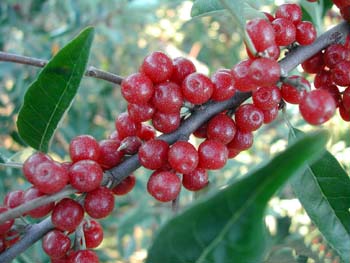Autumn olive: one invasive shrub
A pest of the west and beast of the east, the autumn olive can be one invasive shrub.
Autumn olive is a commonly seen large shrub that has such a pleasant name, it’s almost inviting. Its fragrant spring flowers and bountiful harvest of red berries in the fall obscure the fact that this plant can be an invasive bully. It is seen growing by the hundreds in fields and other areas that are not mowed regularly or maintained. Grassy areas can become a tangled maze of bushes in just a few years.
The question becomes how did it cross our paths and become a regular, though unwanted, sight in Michigan? Autumn olive was first introduced into the United States from Asia in 1830. But the real explosion of greenery began in the 1940s and lasted into the 1970s. Soil conservation districts introduced it through their spring plant sales. They released a variety called ‘Cardinal’ that was known for its prolific red berries. It’s important to keep in mind that the concept of alien or invasive species was pretty new between the 1940s to the ‘60s.
|
Conservation districts saw the benefits of autumn olive. It served as wildlife cover and food, windbreaks, highway barriers and soil stabilizers. It was drought, disease and insect resistant. It could grow in poor soils in full sun to partial shade. The only place it wouldn’t grow was in wet areas or deep shade. Birds and animals relished the berries. But after a short trip through their digestive systems, the berry was utilized, but the seed hit the ground to grow rapidly into an approximately 15-foot-tall bush. Autumn olive only took two or three years before it began flowering and producing berries.
Their growing range is from Maine, south to Tennessee and west to Montana. In the spring, usually May or early June, they flower prolifically with creamy white to pale yellow clusters of small, trumpet-like flowers. They have a powerful, lily-like fragrance. The leaves are longer than they are wide and a gray-green color on top with a silvery underside. Some bushes have thorns, others do not. In August, groups of berries are visible. They are ripe by September or October. Berries are a bright red color. The berries have silvery scales, like polka dots, that make them feel rough and sandpapery. Unripe berries have a great deal of “pucker-power” and the ripe ones are just slightly sweeter. They contain 10 to 14 times more lycopene than a similar weight of tomatoes and are currently being made into jams, wine and meat marinades by enterprising autumn olive entrepreneurs.
Removing bushes becomes more difficult as the bush size increases. Small ones can be pulled up or mowed several times a season. If the only method of attempted control is cutting them, new shoots are produced rapidly. Autumn olive isn’t killed; it’s just pruned. After cutting large bushes, paint the newly-cut stump with glyphosate or a brush killer immediately. If new shoots appear later, spray them to kill them. The most successful method is to remove the autumn olive bush, roots and all. But beware, there is no such thing as a seed that doesn’t grow. So watch for more autumn olives growing now there is more sunlight.



 Print
Print Email
Email





